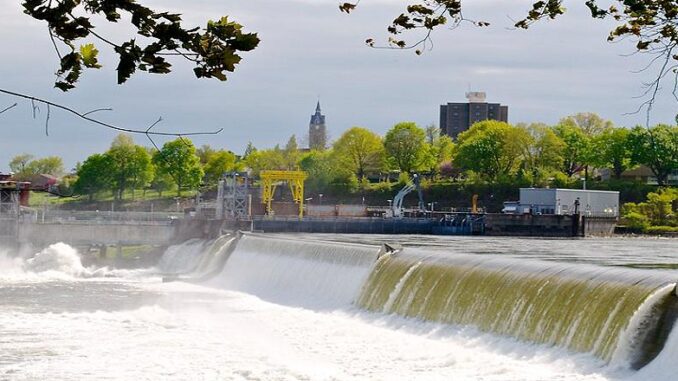
HOLYOKE, Massachusetts, March 23, 2023 (ENS) – The Justice Department, the U.S. Environmental Protection Agency, and the Commonwealth of Massachusetts have entered into a $27 million agreement with the City of Holyoke to reduce overflow sewage discharges into the Connecticut River from the city’s sewer collection and stormwater systems.
“Under the terms of today’s settlement, the City of Holyoke will take additional steps to reduce the amount of untreated sewage discharged during heavy rain events,” said Acting Assistant Administrator Larry Starfield of the EPA’s Office of Enforcement and Compliance Assurance. “The result of this work will be cleaner, safer water for communities that make use of the Connecticut River.”
The Connecticut River is the longest river in the New England region, flowing roughly southward for 406 miles (653 km) through four states. It rises just 300 yards (270 meters) south of the U.S. border with Quebec, Canada, and discharges at Long Island Sound in Connecticut. The watershed takes in more than 2.4 million residents living in some 400 communities.
An industrial city of some 38,000 people, Holyoke owns and operates a sewer collection system that services about 70 percent of the city, two-thirds of which carries both sewage and stormwater.
A combined sewer system collects rainwater runoff, domestic sewage and industrial wastewater into one pipe. State and federal prosecutors allege that the city discharges pollutants from its combined sewer overflow into the Connecticut River in violation of its federal and state wastewater discharge permits. Combined sewer overflow discharges contain raw sewage and are a major water pollution concern.
Under normal conditions, the city transports all of the wastewater to a sewage treatment plant for treatment before discharging to a waterbody. But during periods of heavy rain, the wastewater volume can exceed the carrying capacity of the sewer system or the treatment facility, resulting in the discharge of untreated wastewater to the Connecticut River.
In cooperation with federal and state environmental agencies, the city has taken steps in recent years to address these unlawful discharges, including finalizing a long-term overflow control plan, separating sewers and eliminating overflows in the Jackson Street area.
Known as a consent decree, the settlement reached Wednesday will require the city to undertake further sewer separation work that will eliminate or reduce future overflow discharges, as well as requiring a $50,000 penalty for past permit violations resulting in illegal discharges to the Connecticut River.
The city will also conduct sampling of its storm sewer discharges and work to remove illicit connections.
“Today’s settlement will significantly reduce pollution in the Connecticut River and improve water quality for the Holyoke community,” said Assistant Attorney General Todd Kim of the Justice Department’s Environment and Natural Resources Division.
The river provides drinking water for millions and supports recreational uses and important fisheries for brook trout, winter flounder, blueback herring, alewife, rainbow trout, large brown trout, American shad, hickory shad, smallmouth bass, Atlantic sturgeon, and striped bass.
After an absence of more than 200 years, Atlantic salmon have been reintroduced to the Connecticut by the U.S. Fish and Wildlife Service.
“Fiercely protecting our environment is a civil and human rights issue and ensuring that every community has clean water is a vital part of that work,” said U.S. Attorney Rachael Rollins for the District of Massachusetts. “This consent decree better protects the residents of Holyoke and every single community that lives along and enjoys the Connecticut River.”
This settlement is part of EPA’s continuing efforts to keep raw sewage and contaminated stormwater out of U.S. waters. Raw sewage overflows and inadequately controlled stormwater discharges from municipal sewer systems introduce harmful pollutants, including disease-causing organisms, metals and nutrients that threaten water quality and can contribute to disease outbreaks, beach and shellfish bed closings, flooding, stream scouring, fishing advisories and basement backups of sewage.
The proposed consent decree is subject to a 30-day public comment period and approval by the federal court. Once it is published in the Federal Register, a copy of the consent decree will be available on the Justice Department website at: www.justice.gov/enrd/consent-decrees.
Featured image: The Connecticut River flows past the city of Holyoke and over the Holyoke Dam. May 9, 2019 (Photo by Paul Cooper)



